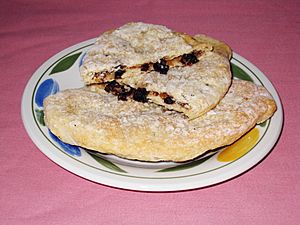Banbury cake facts for kids

Two Banbury cakes, one having been cut into two pieces
|
|
| Place of origin | United Kingdom |
|---|---|
| Region or state | Banbury, Oxfordshire |
| Created by | Edward Welchman |
| Main ingredients | Puff pastry, butter, currants, zest, cinnamon, nutmeg |
A Banbury cake is a tasty, oval-shaped pastry. It is filled with sweet currants and warm spices. Since the mid-1800s, Banbury cakes have become quite similar to another pastry called an Eccles cake. However, the first Banbury cakes were very different from what we eat today.
Besides currants, the filling often includes mixed fruit peel, brown sugar, a little rum, and nutmeg. People traditionally enjoy Banbury cakes with afternoon tea.
Where Banbury Cakes Come From
Banbury cakes were first made and sold only in Banbury, England. This town is in Oxfordshire. People have been making these cakes in the Banbury area since 1586. The recipes were often kept secret.
Even though they are not made in huge amounts anymore, you can still find them there today. In the past, these cakes traveled far. They were sent to places like Australia, the East Indies, and America. They usually traveled in special baskets made in Banbury. You could also buy them at train station snack bars in England.
The History of the Cake
The first Banbury cakes were made by a person named Edward Welchman. His shop was on Parsons Street in Banbury. Some of the earliest recipes for these cakes were written down in the 1600s. One famous book was The English Huswife by Gervase Markham in 1615.
These old recipes are very different from how Banbury cakes are made now. Later recipes were more like tarts or turnovers. An old recipe from the Elizabethan period even included flavors like musk and rosewater. These are not common in modern baking.
Famous Mentions
Even important people enjoyed Banbury cakes. Queen Victoria was given Banbury cakes every August. This happened when she traveled from Osborne to Balmoral.
In the 1800s, the snack rooms at Swindon railway station were known for selling them. A novel by Norman Collins, called London Belongs to Me, mentions them too. In this story, set in 1939, a character named Connie eats a Banbury cake at Victoria Station.
See also
 In Spanish: Banbury cake para niños
In Spanish: Banbury cake para niños

